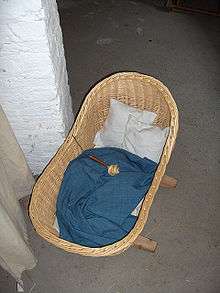Bassinet

A bassinet, bassinette, or cradle is a bed specifically for babies from birth to about four months. Bassinets are generally designed to work with fixed legs or casters, while cradles are generally designed to provide a rocking or gliding motion. Bassinets and cradles are distinguished from Moses baskets and carry cots, which are designed to be carried and sit directly on the floor or furniture. After four months, babies are often transferred to a crib (North American usage) or cot (UK usage). In the United States, however, the bedside sleeper is the prevalent option, since they are generally bigger, recommended up to 6 months, and often used up to a year.
Design
A bassinet is typically a basket-like structure on free-standing legs, often with casters.[1] A cradle is typically set in a fixed frame, but with the ability to rock or glide.[2]
Use
Bassinet usage in the United States nearly doubled to 20% from 1992-2006.[3] Greater than 45% of babies up to two months used a bassinet.[4] By 5–6 months, however, fewer than 10% of babies sleep in bassinets.[5] In a hospital environment, a special form of sealed bassinet is used in a neonatal intensive care unit.
On many domestic and nearly all long-distance flights, most airlines provide a bassinet (which is attached to a bulkhead) to adults travelling with an infant, i.e., a child under the age of two. The use of the bassinet is restricted by the infant's size and weight.[6][7]
Research has shown that the mattress influences SIDS outcomes; a firm mattress lowers SIDS risk.[8]
Some bassinets are designed to rock or swing freely, with many carers finding their child calmed by this action. The process of lulling the child to sleep may be accompanied by prerecorded or live performance of lullabies.
Stationary or portable
Although there are many variations, they fall generally into two categories:
- light and portable types sometimes called Moses baskets
- sturdier but less portable cradles
In both cases, they are generally designed to allow the resting baby to be carried from place to place. Within the home, they are often raised on a stand or other surface to reduce back strain when bending over to tend the baby. Wheeled frames to convert a bassinet into a pram or baby carriage are common.
Rolling
At three or four months of age babies are able to roll over by themselves; this means they could tip the bassinet over, so for safety they must use an infant bed or toddler bed instead.
See also
References
| Wikimedia Commons has media related to Cradles. |
- ↑ Injury Prevention for Children and Adolescents: Research, Practice, and Advocacy, Karen DeSafey Lille, Ed. 2006. p.71.
- ↑ Injury Prevention for Children and Adolescents: Research, Practice, and Advocacy, Karen DeSafey Lille, Ed. 2006. p.71.
- ↑ Pike, Jodi, and Rachel Y. Moon. “Bassinet Use and Sudden Unexpected Death in Infancy.” The Journal of pediatrics 153.4 (2008): 509–512.
- ↑ Pike, Jodi, and Rachel Y. Moon. “Bassinet Use and Sudden Unexpected Death in Infancy.” The Journal of pediatrics 153.4 (2008): 509–512.
- ↑ Pike, Jodi, and Rachel Y. Moon. “Bassinet Use and Sudden Unexpected Death in Infancy.” The Journal of pediatrics 153.4 (2008): 509–512.
- ↑ Example of airline travel information regarding children and infants, Lufthansa
- ↑ Picture of an airplane bassinet, Flickr
- ↑ SIDS & Kids Statement on the use of second hand mattresses